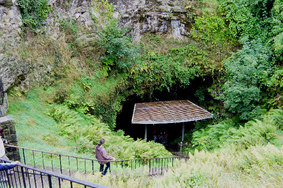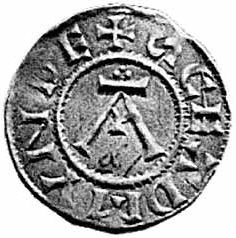 The entrance to Dunmore Cave The entrance to Dunmore Cave I first heard about Dunmore Cave in County Kilkenny, Ireland two years ago while watching an episode of Cities of the Underworld on the History Channel. The fact that stuck in my head was that 1000 people were believed to have been massacred in the cave, in 928AD or 930AD depending on which version of the Irish annals you read. Gothfrith, grandson of Ímar, with the foreigners of Áth Cliath, razed Derc Ferna—something unheard of from ancient times - From the Annals of Ulster The besieging of Derc Ferna and its taking in which one thousand men die. – From the Chronicon Scotorum (Derc Ferna is the ancient name for Dunmore Cave.) Now I have to wonder what the archeological evidence says. I mean if a thousand men were slaughtered there would be some material left behind; bones fragments, axe heads, or a chunk broken from a sword blade. There would be something as it's almost impossible, especially in the early medieval period to eradicate the mess made by slaughtering a thousand people. So what does the evidence tell us? It seems that the cave is littered with bones. Some are animal bones and many of the animals were believed to have been eaten by other animals. Cut marks and burns on the remainder of the animal bones point to their being butchered by humans. Proof that people lived and ate in the cave. And what of the bodies? In 1973 the remains forty-four people were discovered within the cave most of them women and children. There are no signs of violence on any of the skeletons. So what killed them? It’s believed they hid in the cave during the attack. The Vikings then lit fires at the entrance to the cave and suffocated them. But a new look at the evidence is questioning this belief. Most of the objects found in the cave have been of Viking origin.  A silver penny similar to those discovered in the cave A silver penny similar to those discovered in the cave In their paper: Recent Archeological Discoveries in Dunmore Cave, County Kilkenny: Further Questions Regarding Viking Activity at the Site Authors Marion A. Dowd, Linda G. Lynch and Margaret McCarthy list some of the finds: A collection of Viking material, including nine silver coins dating to around 930 AD, were found during excavations in the cave in 1973 (Drew and Huddart 1980, 17). In 1999, a second collection of Viking material - though of later 10th century date - was discovered at the site including 14 Anglo-Saxon silver pennies, a silver penannular arm-ring, hack silver, strap tags and 16 conical-shaped objects woven from silver wire. Of particular interest to me are the silver coins because the native Irish didn’t use coins to trade. Coins were used by the Vikings. Could this be a Viking grave and were the objects recovered grave goods. I don’t know that that answers the whole question, because if that was the case then where are all the men? There have been suggestions that the Vikings lost their silver and coins when they attacked, but there is no evidence of violence in the remains so that can’t be the whole answer either. But there obviously can’t have been a thousand people killed within the walls of the cave. So where did that number come from? It seems that there were two ringforts nearby and the massacre took place there with survivors fleeing to the cave. (At this time I’ve been unable to discover the name or exact location of the forts. If you have some information about them I’d love to hear it.) It’s unfortunate that science has not provided us with any definitive answers when it comes to what actually occurred in the cave and the origins of it’s inhabitants. Perhaps archeologist of the future can discover more about the identities of the bodies in Dunmore Cave. Do you have a history mystery? If you do I’d love to hear about it.
8 Comments
Sandra Dailey
10/18/2014 01:23:16 am
No answers here, but it sounds like the seeds of a good story.
Reply
Marlow
10/18/2014 01:30:15 am
I agree Sandra. It's frustrating when science can't answer my questions.
Reply
Barbara Bettis
10/18/2014 01:35:10 am
How fascinating, Marlow! I hadn't heard about this cave or the massacre. At the moment, I can't come up with a mystery to share--
Reply
Marlow
10/18/2014 03:32:07 am
Thanks Barbara. If you ever come across a mystery in any time period I'd love to hear about it.
Reply
Mary Morgan
10/18/2014 09:11:05 am
Definitely one to ponder. Sacrafice? But for what? And remember, the tale most likely started with a bardic story and grew over the years. So, 40 turned to 100, turned 1,000? Fascinating as always, Marlow! And can't think of any historical mysteries at the moment...
Reply
Marlow
10/19/2014 03:16:21 am
I never considered sacrifice. Maybe because the Irish aren't known for human sacrifice, but the vikings are, so that put a different twist on it. Thanks Mary.
Reply
10/20/2014 02:56:47 pm
Interesting story. I don't have a theory, but I'll think on it. This is pretty late for Viking raids or attacks. But there must be a basis for the story in some kind of event. Hmmm.
Reply
Marlow
10/20/2014 10:54:47 pm
Thanks Mary, It's great t have your input. I didn't think of the time scale when it comes to Viking raids but I suppose they must've occurred until Brian Boru expelled them in the Battle of Clontarf in 1014AD.
Reply
Leave a Reply. |
|
